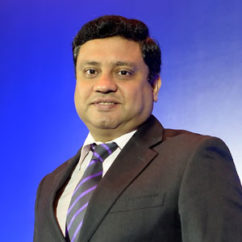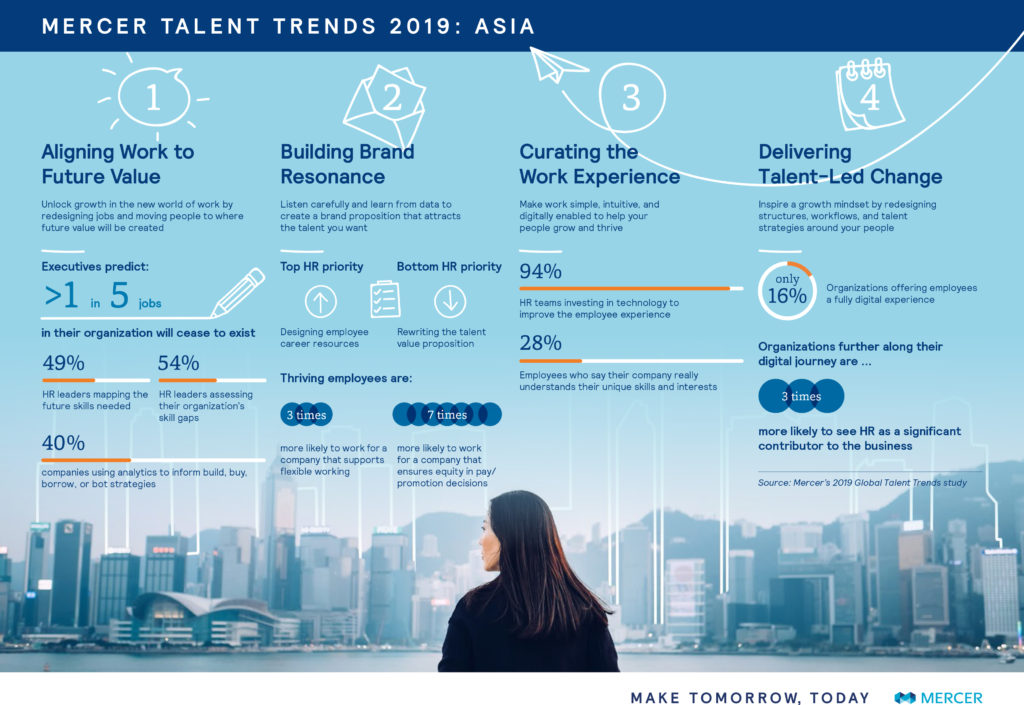Asia’s Businesses: Becoming Future-Fit in the Human Age

Employees leave their offices in Beijing. Executives in China, India and Hong Kong proclaim the need for job redesign while few Japanese and Singaporean executives have this on their radar.
Photo: Frederic J. Brown/AFP/Getty Images
When Prudential Hong Kong automated some of its front and back office systems, it expected transformational results. But the anticipated savings didn’t materialize. To discover why, the insurer used an activity survey and employee interviews to quickly identify what work was being done and by whom. The insights led to better-informed work designs and enabled HR to suggest where resources could evolve into future roles.
Prudential’s story reveals the urgency of rethinking the people agenda to unlock potential, particularly as almost all organizations are taking action to prepare for the future of work, according to Mercer’s 2019 Global Talent Trends study. One of the main drivers of all this activity is the surge in awareness of disruption—71 percent of Asian executives are predicting significant disruption in the next few years.
Yet, as executives focus on making their organizations future-fit, there is growing sensitivity to the human capital risks that can impede transformation efforts. In today’s uncertain climate, employees seek stability; HR is concerned that with uncertainty comes low engagement, employee apathy and change fatigue. Mercer’s study finds that job security is one of the main reasons employees in Asia joined their company and stayed with it. Addressing people concerns is paramount, given that only one in three executives rate their company’s ability to mitigate human capital risks as very effective, dropping to just one in five in Japan.
The way to help employees feel secure is to foster engaging human connections so individuals can thrive in their careers, even if their job is evolving around them. The key is ensuring individuals feel they have a career for life, not a job for life. The study identifies the following four trends that leading companies are addressing in 2019.
Aligning Work to Future Value
Agility remains a critical organizational competency. But agility alone is not enough. Further, as more companies move to flatter work structures and embrace agile work models, new value creation opportunities are needed to stay ahead.
Leading firms are aligning change efforts to a few anchor points where they believe future value will be created—be it new products, new critical skills or new operating models. The key to success will be redefining the “jobs to be done,” as Prudential did, and uncovering ways to optimize current roles. This year, the C-suite across the world named job redesign as the area of talent investment with the highest return on investment potential. Yet, the picture is more mixed in Asia, with executives in China, India and Hong Kong proclaiming the need for job redesign, while few Japanese and Singaporean executives have this on their radar.
The challenge for HR across the region is to deliver an integrated people strategy that can execute on these priorities—an approach deployed four times more by high-growth companies* globally—and to get creative about how to reward future valued behaviors.
Building Brand Resonance
Attracting top talent remains a priority globally. What has changed, however, are employees’ perceptions of what makes a desirable employer. Job seekers today care as much about the way a company conducts business and upholds its values as the business it is in.
In a transparent and socially connected world, one way to build a sustainable talent pipeline is to ensure a company’s brand and its talent value proposition (TVP) resonate with all workforce segments, contingent workers included. Companies in Singapore and China are already making headway in this regard; indeed, in China over four in five high-growth organizations differentiate their TVP to different groups, compared to fewer than one in four in modest-growth companies. Part of delivering on the value proposition is advancing the diversity and inclusion agenda locally. In Asia, thriving employees are seven times more likely to work for a company that ensures equitable pay and promotion, but only 12 percent of companies in Asia actively measure pay inequities. Clearly, this is an area that warrants more attention in 2019.
Curating the Work Experience
Making work simple, intuitive and digitally enabled helps people grow and thrive. Advances in artificial intelligence are opening up a new world of benefits, training and career offerings tailored to each individual’s needs and preferences—although implementation varies by geography. In the U.S., for example, HR is investing mainly in chatbots and AI tools to enhance the employee experience; in China, meanwhile, companies are focused on AI for talent matching and delivering automated talent management. This will deliver a differentiated work experience.
What we found interesting is that employees’ curation preferences largely map to geographical differences, too. Employees in North America and Australia prefer the curated approach to learning, while those in Asia prefer having a training budget to spend as they like. The delivery method may partly explain the difference—70 percent of employees in Asia say their company offers state-of-the-art digital tools to support their training and development, compared to only 51 percent in North America. This data highlights the importance of nimble, adaptive knowledge-sharing platforms, such as that offered by New Zealand’s Spark. The Internet service provider uses an automated platform to suggest learning based on an employee’s KPIs on which skills they perform well and which need improvement.
Delivering Talent-Led Change
High turnover, low engagement and change fatigue all appear to be stalling progress. One in four of Asia’s executives are asking for employee metrics on burnout, while attrition is one of HR leaders’ top concerns when it comes to implementing change.
To ensure the human agenda is front and center, HR should have a stronger voice in business transformation. It is encouraging that so many of Asia’s HR leaders get involved with planning the rollout of major change—the highest of the regions studied; 80 percent of China’s HR leaders do so and 62 percent in India, for instance. Yet, only two in five HR leaders say they currently participate in the early stage of transformation when ideas are scoped out. This needs to change. Mercer’s global data reveal that when HR is bold, the business benefits: 53 percent of high-growth organizations say HR is involved in kick-starting major change, compared to 39 percent of modest-growth organizations.
What is apparent throughout this year’s study is the need for connectivity—whether individuals feel connected to each other, to their work or to the brand. Successful organizations will be those that engage in active and generous dialogue with their people and seek to understand and inspire them in the year ahead.
*High-growth companies self-reported revenue growth of 10 percent or more in the last three years, while modest-growth companies self-reported revenue growth of 5 percent or less during the same period.
**Mercer’s annual Global Talent Trends study features insights from more than 7,300 senior business executives, HR leaders and employees from nine industries and 16 countries.






